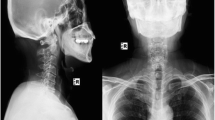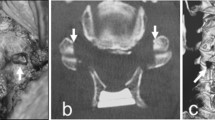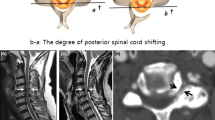Abstract
Purpose
Between 2006 and 2010, we performed wide laminectomy (wide LAM) alone, with decompression performed between the bilateral medial margin of the zygapophyseal joints, or double-door laminoplasty (DL) combined with wide LAM for cervical compressive myelopathy (CCM). From 2010, instead of wide LAM and DL, we began to perform narrow LAM, where the laminectomy width was no more than 2–3 mm wider than the spinal cord width (SW). This study aimed to elucidate the risk factors for C5 palsy by reviewing surgical outcomes.
Methods
The clinical features and radiological findings of 263 CCM patients with or without C5 palsy were compared. Risk factors for C5 palsy were assessed using logistic regression analysis. The decompression width (DW) was defined as the laminectomy width or the width between the bilateral medial margins of the bony gutters in DL.
Results
Narrow LAM reduced the incidence of C5 palsy from 9.2 to 1.2%. DL was performed more frequently in the C5 palsy group. The difference between the DW and the SW (DW − SW) was significantly greater in the C5 palsy group. Posterior spinal cord shift, aging, and the number of consecutive laminae surgically treated were significantly higher in the C5 palsy group. The diameter of the foramen (DF) at C4/5 was significantly smaller in the C5 palsy patients. The logistic regression analysis revealed that DL, DW − SW, DF, and aging were risk factors for C5 palsy.
Conclusions
Cervical laminectomy of limited width prevented postoperative C5 palsy without compromising the functional recovery.



Similar content being viewed by others

References
Chiba K, Ogawa Y, Ishii K, Takaishi H, Nakamura M, Maruiwa H, Matsumoto M, Toyama Y (2006) Long-term results of expansive open-door laminoplasty for cervical myelopathy–average 14-year follow-up study. Spine (Phila Pa 1976) 31:2998–3005. doi:10.1097/01.brs.0000250307.78987.6b
Iwasaki M, Kawaguchi Y, Kimura T, Yonenobu K (2002) Long-term results of expansive laminoplasty for ossification of the posterior longitudinal ligament of the cervical spine: more than 10 years follow up. J Neurosurg 96:180–189
Kato Y, Iwasaki M, Fuji T, Yonenobu K, Ochi T (1998) Long-term follow-up results of laminectomy for cervical myelopathy caused by ossification of the posterior longitudinal ligament. J Neurosurg 89:217–223. doi:10.3171/jns.1998.89.2.0217
Imagama S, Matsuyama Y, Yukawa Y, Kawakami N, Kamiya M, Kanemura T, Ishiguro N (2010) C5 palsy after cervical laminoplasty: a multicentre study. J Bone Jt Surg Br 92:393–400. doi:10.1302/0301-620x.92b3.22786
Fan D, Schwartz DM, Vaccaro AR, Hilibrand AS, Albert TJ (2002) Intraoperative neurophysiologic detection of iatrogenic C5 nerve root injury during laminectomy for cervical compression myelopathy. Spine (Phila Pa 1976) 27:2499–2502. doi:10.1097/01.brs.0000031313.90883.29
Chiba K, Toyama Y, Matsumoto M, Maruiwa H, Watanabe M, Hirabayashi K (2002) Segmental motor paralysis after expansive open-door laminoplasty. Spine (Phila Pa 1976) 27:2108–2115. doi:10.1097/01.brs.0000025693.11896.b3
Shiraishi T, Kato M, Yato Y, Ueda S, Aoyama R, Yamane J, Kitamura K (2012) New techniques for exposure of posterior cervical spine through intermuscular planes and their surgical application. Spine (Phila Pa 1976) 37:E286–E296. doi:10.1097/BRS.0b013e318239cc7e
Shiraishi T, Fukuda K, Yato Y, Nakamura M, Ikegami T (2003) Results of skip laminectomy-minimum 2-year follow-up study compared with open-door laminoplasty. Spine (Phila Pa 1976) 28:2667–2672. doi:10.1097/01.brs.0000103340.78418.b2
Shiraishi T, Yato Y (2002) New double-door laminoplasty procedure for the axis to preserve all muscular attachments to the spinous process: technical note. Neurosurg Focus 12:E9
Hatta Y, Shiraishi T, Hase H, Yato Y, Ueda S, Mikami Y, Harada T, Ikeda T, Kubo T (2005) Is posterior spinal cord shifting by extensive posterior decompression clinically significant for multisegmental cervical spondylotic myelopathy? Spine (Phila Pa 1976) 30:2414–2419
Bydon M, Macki M, Kaloostian P, Sciubba DM, Wolinsky JP, Gokaslan ZL, Belzberg AJ, Bydon A, Witham TF (2014) Incidence and prognostic factors of c5 palsy: a clinical study of 1001 cases and review of the literature. Neurosurgery 74:595–604. doi:10.1227/neu.0000000000000322 (discussion 604–595)
Nakashima H, Imagama S, Yukawa Y, Kanemura T, Kamiya M, Yanase M, Ito K, Machino M, Yoshida G, Ishikawa Y, Matsuyama Y, Hamajima N, Ishiguro N, Kato F (2012) Multivariate analysis of C-5 palsy incidence after cervical posterior fusion with instrumentation. J Neurosurg Spine 17:103–110. doi:10.3171/2012.4.spine11255
Gu Y, Cao P, Gao R, Tian Y, Liang L, Wang C, Yang L, Yuan W (2014) Incidence and risk factors of C5 palsy following posterior cervical decompression: a systematic review. PLoS One 9:e101933. doi:10.1371/journal.pone.0101933
Hasegawa K, Homma T, Chiba Y (2007) Upper extremity palsy following cervical decompression surgery results from a transient spinal cord lesion. Spine (Phila Pa 1976) 32:E197–E202. doi:10.1097/01.brs.0000257576.84646.49
Takenaka S, Hosono N, Mukai Y, Miwa T, Fuji T (2013) The use of cooled saline during bone drilling to reduce the incidence of upper-limb palsy after cervical laminoplasty: clinical article. J Neurosurg Spine 19:420–427. doi:10.3171/2013.7.spine13144
Tsuzuki N, Abe R, Saiki K, Zhongshi L (1996) Extradural tethering effect as one mechanism of radiculopathy complicating posterior decompression of the cervical spinal cord. Spine (Phila Pa 1976) 21:203–211
Baba S, Ikuta K, Ikeuchi H, Shiraki M, Komiya N, Kitamura T, Senba H, Shidahara S (2016) Risk factor analysis for c5 palsy after double-door laminoplasty for cervical spondylotic myelopathy. Asian Spine J 10:298–308. doi:10.4184/asj.2016.10.2.298
Klement MR, Kleeman LT, Blizzard DJ, Gallizzi MA, Eure M, Brown CR (2016) C5 palsy after cervical laminectomy and fusion: does width of laminectomy matter? Spine J 16:462–467. doi:10.1016/j.spinee.2015.07.437
Tsuzuki N, Zhogshi L, Abe R, Saiki K (1993) Paralysis of the arm after posterior decompression of the cervical spinal cord. I. Anatomical investigation of the mechanism of paralysis. Eur Spine J 2:191–196
Radcliff KE, Limthongkul W, Kepler CK, Sidhu GD, Anderson DG, Rihn JA, Hilibrand AS, Vaccaro AR, Albert TJ (2014) Cervical laminectomy width and spinal cord drift are risk factors for postoperative C5 palsy. J Spinal Disord Tech 27:86–92. doi:10.1097/BSD.0b013e31824e53af
Shiozaki T, Otsuka H, Nakata Y, Yokoyama T, Takeuchi K, Ono A, Numasawa T, Wada K, Toh S (2009) Spinal cord shift on magnetic resonance imaging at 24 hours after cervical laminoplasty. Spine (Phila Pa 1976) 34:274–279. doi:10.1097/BRS.0b013e318194e275
Lee HJ, Ahn JS, Shin B, Lee H (2017) C4/5 foraminal stenosis predicts C5 palsy after expansive open-door laminoplasty. Eur Spine J. doi:10.1007/s00586-017-5077-8
Katsumi K, Yamazaki A, Watanabe K, Ohashi M, Shoji H (2013) Analysis of C5 palsy after cervical open-door laminoplasty: relationship between C5 palsy and foraminal stenosis. J Spinal Disord Tech 26:177–182. doi:10.1097/BSD.0b013e31823db346
Sasai K, Saito T, Akagi S, Kato I, Ohnari H, Iida H (2003) Preventing C5 palsy after laminoplasty. Spine (Phila Pa 1976) 28:1972–1977. doi:10.1097/01.brs.0000083237.94535.46
Hosono N, Miwa T, Mukai Y, Takenaka S, Makino T, Fuji T (2009) Potential risk of thermal damage to cervical nerve roots by a high-speed drill. J Bone Jt Surg Br 91:1541–1544. doi:10.1302/0301-620x.91b11.22196
Author information
Authors and Affiliations
Corresponding author
Ethics declarations
Conflict of interest
The authors have no conflict of interests to report concerning the materials or methods used in this study or the findings described in this paper.
Rights and permissions
About this article
Cite this article
Nori, S., Aoyama, R., Ninomiya, K. et al. Cervical laminectomy of limited width prevents postoperative C5 palsy: a multivariate analysis of 263 muscle-preserving posterior decompression cases. Eur Spine J 26, 2393–2403 (2017). https://doi.org/10.1007/s00586-017-5202-8
Received:
Revised:
Accepted:
Published:
Issue Date:
DOI: https://doi.org/10.1007/s00586-017-5202-8



